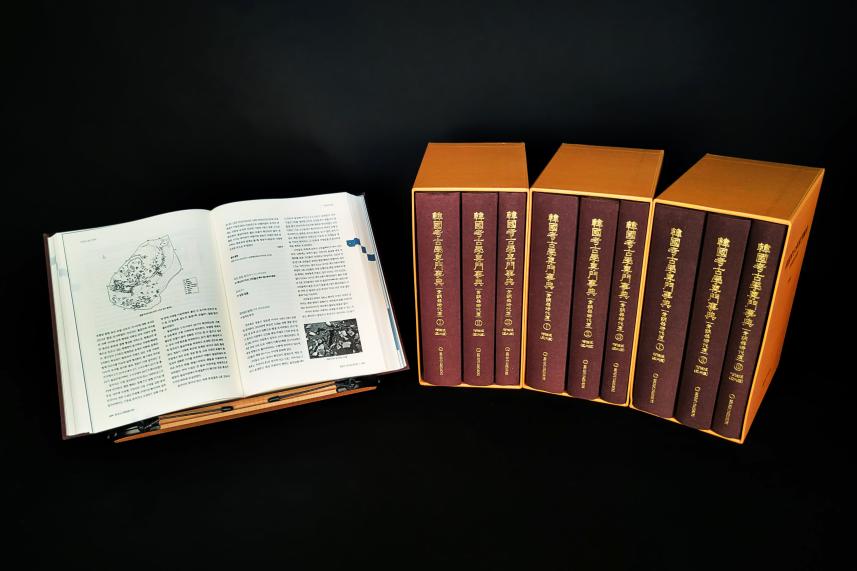|
청동기 시대 최신 연구 성과 담은 표제어와 사진·도면 시각자료 보충
문화재청 국립문화재연구원(원장 김연수)은 지난 2004년 『한국고고학전문사전-청동기 시대 편』을 간행한 이후 이루어진 최신 연구 성과들을 보충하여 국내 편(Ⅰ·Ⅱ)과 국외 편(Ⅲ)으로 구성한 증보판 사전을 발간하였다.
개념 표제어 221건(국내 130건, 국외 91건), 유적 표제어 1,911건(국내 1516건, 국외 395건) 등 모두 2,132건을 수록하였으며, 이해를 도울 관련 사진·도면 등 시각적인 연구 성과 자료와 색인 등도 함께 실었다.
▲ 국내 편(Ⅰ·Ⅱ)은 청동기 시대에 대한 최신 연구 성과를 보강해 총 두 권으로 구성했으며, ▲ 국외 편(Ⅲ)에는 한반도를 비롯한 동북아시아의 청동기 문화를 총체적으로 이해하는 데 도움이 될 수 있도록 중국, 일본, 카자흐스탄, 몽골, 러시아 등의 청동기 문화상을 살펴볼 수 있는 유적, 유물 등 관련 용어 및 이에 대한 해설을 함께 수록하였다.
또한, 빈번하게 사용되는 청동기 시대 관련 한자어 표기 용어를 한글로 순화한 “청동기 시대 전문 용어 한글표준안”을 마련하여 사전을 찾아보는 이용자들이 쉽게 이해하고 사용할 수 있도록 했다. 앞으로 각종 고고학 관련 전시나 도서 발간, 영상 등에서도 이러한 한글표준안이 많이 사용되어 국민들이 더 쉽게 우리 문화유산을 이해하는 데 도움이 되기를 바란다.
『한국고고학전문사전-청동기 시대 편』증보판은 국내 관련 연구 기관 등에 배포하고, 국립문화재연구원 문화유산연구지식포털 누리집(http://portal.nrich.go.kr)을 통해서도 누구나 열람할 수 있도록 하였다.
문화재청 국립문화재연구원은 이번을 마지막으로 출판인쇄물 형식의 고고학 사전 발간은 마무리하고, 그동안 발간된 자료를 포함하여 앞으로 새로 구축될 자료를 모두 디지털체계로 전환하여 국민 모두가 쉽게 접근하여 활용할 수 있도록 서비스를 개선해 나갈 것이다. The National Research Institute of cultural Heritage publishes three volumes – Korea (Volumes I and II), and CHN•JPN•KAZ•MNG•RUS (Volume III), of revised and expanded version of the Dictionary of Korean Archaeology – Bronze Age – supplemented with up-to-date research outcomes from after publishing the Dictionary of Korean Archaeology – Bronze Age – in 2004.
To help the public to clearly apprehend, a total of 2,132 entries including 221 terms (130 from Korea, 91 from overseas) and 1,911 (1,516 from Korea, 395 from overseas) archaeological sites were included as well as visual materials such as plans and images.
Volumes I and II (Korea) were supplemented with the most recent research outcomes and constitute 2 books. while Volume III (CHN•JPN•KAZ•MNG•RUS) contains details about archaeological sites, artifacts and related terms about Japan, China, Russia and other countries to help understand the extensive Bronze Age cultures within Northeast Asia alongside Korean Peninsula.
Moreover, this revised and extended version puts forward a “Hangeul Standardization of Bronze Age terminology”, clarifying frequently used Sino-Korean words in relation to the Bronze Age to help readers to comprehend and utilize the materials even better. It is hoped to set a guideline which can be used within any kind of media including exhibitions, books and audiovisual materials related to archaeology and facilitate people to understand our cultural heritage.
The revised and extended Dictionary of Korean Archaeology – Bronze Age – will be distributed to research institutions, affiliated establishments and researchers nationwide, and made available on the Cultural Heritage Research Knowledge Web Portal (http://portal.nrich.go.kr) for the general public.
Lastly, the National Research Institute of Cultural Heritage of the Cultural Heritage Administration plans to conclude the publication of the Dictionary of Korean Archaeology in the form of printed materials with this issue and go through a digital conversion and make all previously published contents and future study outcomes digitally available online to facilitate the access and utilization thereof.

< 고고학사전 청동기 시대 증보판 사진 보정본 > |

